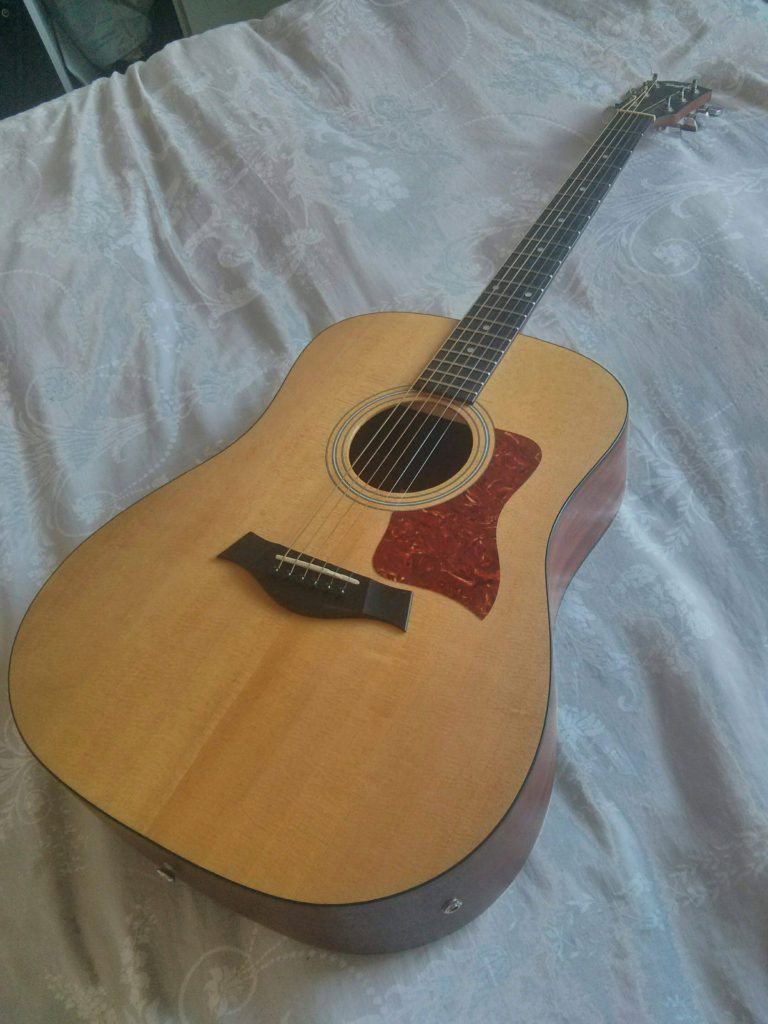
I didn’t have a single issue with my Taylor 110e acoustic guitar in the 10 years spent with it. So why did I let it go?
Outdated electronics
My Taylor 110e featured Taylor’s now-defunct ES-Blue pickup system, devoid of any such niceties as EQ or an even end-pin mounted jack. Battery access? well, that was installed directly onto the inside of the top. You couldn’t really get more basic or rough around the edges, with the jack socket protruding untidily out from the same position as a Les Paul, or in other words exactly where you don’t want it for mostly sat-down acoustic work.
Taylor has since moved on with their far superior 3-band Expression system.
In practice, the amplified tone isn’t offensive, but the chances are it won’t be perfect for the venue either, in which case you’ll need outboard eq, which is a chore. The tone is exactly what you’d expect, which is a clean electric tone with a dash of acoustic, rather than pure acoustic what you’d hoped it to be, it seems rubbery and unresponsive, predictably synthetic, and worst of all, uninspiring.
Spec for the money
At the time of purchase (around 2005), we were talking £450+ for a solid Sitka Spruce top with laminated Sapele sides. These days, fully solid instruments can be had for less, and with far superior electronics to boot.
Build Quality
Rudimentary electronics aside, the construction of the Taylor 110e is rather shabby, to say the least. First off is the bridge, billed as ebony, but as it turns out it’s a lighter coloured wood with a darker finish, which started to peel away almost immediately.
The headstock is similarly low-rent, with a very cheap-looking white transfer Taylor logo on a black veneer (since upgraded to Indian Rosewood on later models).
Soundhole ornamentation is a simple as it gets, but more disappointingly, the back and sides or also very scruffily finished. Some would say the thin lacquer coating is a benefit. I’d say it’s merely slapdash.
All in all, not the tidiest of packages.
Lack of Personality
I’ll always remember the first strum on the Taylor 110e. Its acoustic tone is bright, and a real eye-opener compared to what it was replacing, a Simon & Patrick Cedar SP6 (Closest recent model here). But more than the brightness was the clarity and an uncanny, almost chorus-like sheen. For a time I revelled in the zing of the piano-like bass note tones, which were a world away from the woody thud of the Simon & Patrick (my main reason for letting it go), the increase in volume, thanks to the Taylor 110e’s signature ‘bowled’ back, the Taylor calling card of electric-like neck dimensions and playability, and the rock-solid reliability and kudos of USA-built instrument by one the best name in the business.
But as the years went by, the Taylor provided me with nothing new. No issues, no breakages, no degradation, but also no fun, no inspiration, no surprises, no personality.
And then I began to realise, for vocal accompaniment, its main job, the Fender-esque icy response of the Taylor wasn’t really a good foil for the similar qualities in my voice. The Simon & Patrick, with its earthy bass and muted high end, was a better match, and as a result, that guitar got a lot more songs out of it despite its on-paper inferiority.
It’s not all about specs and brand
So there you have it, I was almost heartbroken to see the Simon & Patrick go. Despite its flaws, it had all the songs, all the history, It had become a friend, even accompanying me to Goa (full story here). When it went, a part of me went with it.
On the other hand, I had the Taylor 110e for longer, but there was no sense of loss at all. It had delivered, yes, but it hadn’t inspired, I hadn’t fallen in love with it.
As a musician and songwriter, I truly believe our very best work comes from using instruments that have that extra-special something, beyond specs and brand. It’s that deep, comforting connection of knowing it’ll surprise you in inspiring ways, gift you an idea or even a whole song. Guitars are not just a collection of parts, they have the capacity within them to change the world.
… I really miss that Simon & Patrick.
Taylor 110e Sound examples.
Take a listen to a couple of my own Tracks featuring the Taylor 110e
You can also purchase my album. This is Who I am on Amazon, Apple Music, Google Play Music etc.
Taylor 110e Acoustic Gallery
Taylor 110e specs
- Type/Shape: 6-String Dreadnought
- Back & Sides: Sapele Laminate
- Top: Sitka Spruce
- Soundhole Rosette: Plastic
- Neck: Sapele
- Fretboard: Ebony
- Fretboard Inlay: Pearloid Dots
- Binding: Black
- Bridge: Ebony
- Nut & Saddle: Tusq
- Tuning Machines: Enclosed, Die-Cast Chrome Plated
- Strings: Elixir® Medium Gauge Strings with NANOWEB Coating
- Scale Length: 25 1/2 Inches
- Truss Rod: Adjustable
- Neck Width at Nut: 1 11/16 Inches
- Number of Frets: 20
- Fretboard Radius: 15 Inches
- Bracing: X-Brace
- Finish: Varnish
- Color Options: Natural
- Sunburst Options: None
- Cutaway: None
- Electronics: Taylor ES-Blue
- Left-Handed: Available; No Charge
- Body Width: 16 Inches
- Body Depth: 4 5/8 Inches
- Body Length: 20 Inches
- Overall Length: 41 Inches
- Case: Gig Bag
Other Guitar Gear Reviews @ The Blogging Musician.



Thanks for stopping by Kyle. Yeah for the money the Taylor 110e was a solid purchase.
I love my 2013 Taylor 110e. So much so that I bought another. I had a Taylor 310 1998 that I loved but I had to let go due to no bass response. Bass had apparently been amputated. The 110e is a vast improvement, I only wish it had a gloss top. For under $500, a working musician’s guit box.
Hi,
Can you confirm 110e nut width???
Thank you,
Seamus.